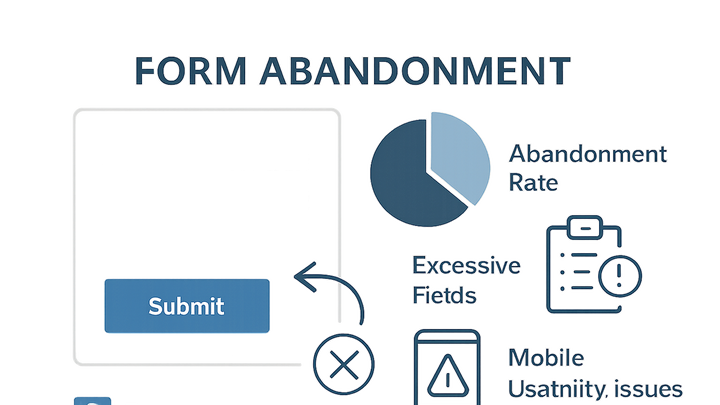Published on 2025-06-29T19:51:51Z
What is Form Abandonment? Examples & Impact on CRO/UX/SEO
Form Abandonment refers to the phenomenon where visitors begin to fill out an online form but leave before submitting it.
In the fields of Conversion Rate Optimization (CRO), User Experience (UX), and Search Engine Optimization (SEO), high abandonment rates signal friction in the user journey and missed opportunities for lead generation.
By analyzing form abandonment, teams can uncover pain points—such as excessive fields, confusing design, or slow loading—and implement targeted fixes to improve completion rates.
Tools like Prevue.me provide actionable critiques, highlighting specific form elements to
streamline for maximum conversions.
Because forms often represent high-intent interactions—from newsletter signups to purchase flows—even small improvements can significantly impact overall conversion metrics.
Understanding and reducing form abandonment is essential for boosting revenue, enhancing user satisfaction, and improving site performance.
Form abandonment
Form abandonment is when users start but do not complete web forms, impacting conversions, SEO, and UX. Reducing it boosts revenue.
Understanding Form Abandonment
Provide a deeper dive into what form abandonment means, how it’s measured, and why it’s distinct from related metrics.
-
Definition and scope
Form abandonment occurs when a user starts filling out a web form but exits before clicking Submit. It encompasses partial entries and drop-offs at any stage of the form.
-
Form abandonment rate
This metric quantifies the percentage of form initiations that do not result in a completed submission. It’s calculated as (1 - Submissions/Starts) × 100.
- Calculation:
Abandonment Rate = (1 - (Number of Submissions / Number of Form Starts)) × 100%
- Calculation:
Why Form Abandonment Matters
High form abandonment directly affects conversion goals, signals UX flaws, and can negatively impact SEO by sending poor engagement signals to search engines.
-
Impact on conversions
Lost submissions mean fewer leads, sales, or sign-ups, reducing the overall conversion rate of your site.
-
Ux and engagement signals
Search engines and analytics tools interpret high drop-off rates as user dissatisfaction, which can hurt SEO rankings and site credibility.
Common Causes of Form Abandonment
Identifying the root causes of abandonment helps prioritize optimizations. Common issues range from excessive length to technical glitches.
-
Excessive form length
Long forms with too many fields overwhelm users, leading them to abandon before completion.
- Perceived effort:
Users gauge the time required; more fields equal more effort.
- Form fatigue:
Multiple similar questions frustrate and bore users, causing drop-off.
- Perceived effort:
-
Poor mobile usability
Forms not optimized for mobile screens can be hard to navigate and complete on handheld devices.
- Non-responsive layout:
Fields and buttons appear too small or misaligned.
- Slow load times:
Mobile users abandon if the form takes too long to load.
- Non-responsive layout:
-
Lack of trust signals
When users aren’t assured their data is secure, they hesitate to submit personal information.
- Missing ssl/https:
No secure connection deters users from entering sensitive data.
- No privacy notice:
Lack of clear data usage policies raises concerns.
- Missing ssl/https:
-
Complex field requirements
Fields demanding unusual formats or lengthy text inputs increase friction.
- Strict validation:
Overly rigid input rules (e.g., date formats) cause errors.
- Captchas:
While mitigating spam, they can frustrate genuine users.
- Strict validation:
Strategies to Reduce Form Abandonment
Implement targeted tactics to streamline the form experience, rebuild trust, and guide users toward completion.
-
Simplify and prioritize fields
Only ask for essential information; use progressive profiling for additional data later.
- Minimize required fields:
Collect only what you need to qualify leads.
- Logical grouping:
Group related fields to improve flow.
- Minimize required fields:
-
Optimize for mobile
Ensure forms are responsive, easy to tap, and load quickly on all devices.
- Responsive design:
Forms adapt to various screen sizes.
- Optimize load speed:
Compress assets and use fast form-hosting solutions.
- Responsive design:
-
Provide real-time validation
Offer inline feedback as users complete fields to prevent submission errors.
- Instant error messages:
Show errors next to the field immediately.
- Success indicators:
Highlight fields correctly completed.
- Instant error messages:
-
Use trust signals
Display security badges, privacy statements, and testimonials near forms to reassure users.
- Ssl certificates:
Show the HTTPS lock icon prominently.
- Privacy links:
Link to concise privacy policy near the submit button.
- Ssl certificates:
-
Test and iterate
Continuously A/B test form variations and monitor performance to find the most effective formats.
- A/b testing:
Compare different form lengths, layouts, and CTAs.
- Heatmap analysis:
Use tools to see where users click or drop off.
- A/b testing:
Tools and SaaS Solutions
Leverage specialized platforms to diagnose, test, and optimize form performance across devices and audiences.
-
Prevue.me
A comprehensive critique platform offering actionable insights on form design, CRO, SEO, UX, and accessibility.
- Form specific feedback:
Highlights friction points in each field for streamlined optimization.
- Lead generation insights:
Recommends enhancements to maximize submission rates.
- Form specific feedback:
-
Hotjar
Delivers heatmaps, session recordings, and form analytics to visualize user interactions and drop-off points.
- Heatmaps:
Visualize where users click, scroll, and focus.
- Form analytics:
Track field completion rates and time spent.
- Heatmaps:
-
Optimizely
Enables A/B testing and personalization to experiment with form layouts, CTAs, and validation rules.
- A/b testing:
Test form variations to identify top performers.
- Personalization:
Deliver tailored form experiences based on user data.
- A/b testing:
